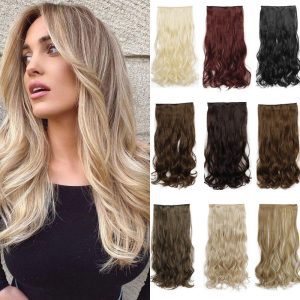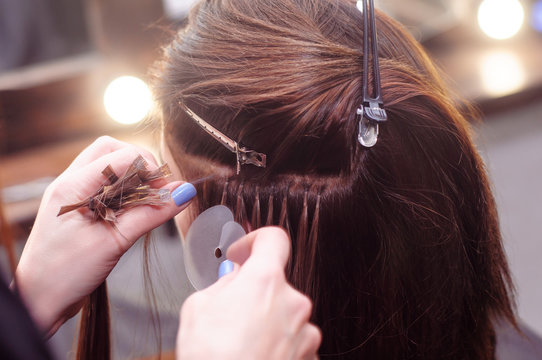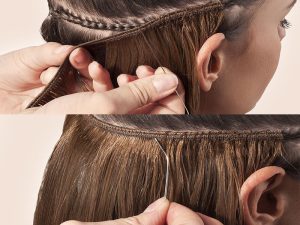Hair extensions are a popular trend in the fashion industry. They have been available for many years, but recently they have become very popular. They are perfect for those who want to enhance their looks and have less maintenance than regular hair extensions. However, there are some people who prefer to go with the sew-in method because they like the way it looks.

Finding the right one for you and your hair type can be difficult. The two most popular hair extension types for ladies are clip-in and sew-in.
Both are excellent ways to give one's natural hair more length, texture, and volume. But it's important to understand that these two categories of extensions are not equivalent.
If you're unsure which one to acquire, this blog will guide you because we'll detail the differences between clip-in and sew-in extensions.
What Are Clip-In Extensions?
The most well-liked and practical way to give your natural hair length, volume, and the colour is with clip-in hair extensions. Clip-ins can rapidly modify your look by adding longer, thicker hair. Clip-in extensions have several advantages and disadvantages. As a result, they are preferred as a hair enhancement technique by both professionals and regular consumers.
The temporary clip-in hair extensions are easy to use. The application can be finished in a short time. They are fastened with non-damaging pressure-sensitive clips.
When properly cared for and maintained, clip-in hair extension sets are far less expensive than sewn-in hair extensions. Women can take off clip-ins anytime, anywhere, which is their most fantastic perk.
To fulfil diverse stylistic needs, clip-in hair extensions are available in many colours, from bright to dark, and in a vast selection of textures and lengths. There are also affordable clip-in extensions composed of synthetic fibres available.

Types of Clip-In Extensions:
Human Hair Clip-In Extensions
Human hair clip-in hair extensions are the best. They give out the most natural looks and feels, last the longest, and provide the most styling options when used with heat styling equipment. The best available clip-on extensions are made of Remy human hair. The cuticles are still present in Remy's hair, which has undergone minimal processing. Your hair is consequently healthier, shinier, and almost tangle-free.
Synthetic Clip-In Extensions
Unlike natural hair clip-in extensions, synthetic clip-ins are less expensive. Synthetic hair is an excellent option for special events because it is weather-resistant.
Before spending money on human hair clip-in extensions, synthetic clip-in extensions are the most practical and best way to experiment with various looks. Before degeneration begins to be visible, synthetic hair typically lasts one to three months.
The Benefits of Clip-In Hair Extensions
In comparison to sew-in extensions, clip-in extensions are more ambiguous. You have the freedom to wear and remove clip-ins whenever you wish. You may quickly change the way you look with clip-in hair extensions. Do you desire a longer ponytail? Want to switch your appearance from day to night? Using clip-in hair extensions is a terrific option to change your appearance while on the go.
Your confidence can be increased most effectively with clip-in hair extensions. You can quickly choose between different lengths and textures.
What Are Sew-In Extensions?
Your hair can be lengthened, volumized, and given more texture using sew-in additions, sometimes called weave hair extensions. Weft human hair extensions are sewed into your braids using a needle and thread to protect your natural hair from frequent heat styling.
As the extensions are sewed into the braids, sew-ins are excellent for people with thick or coarse hair because they can harm weak hair.
Instead of clip-in extensions, sewn hair extensions require a full installation time of three to six hours. Hiring a professional to install sew-ins is recommended unless you have perfected the craft. Attempting to put sew-in weaves by yourself carries several dangers, including the potential for scalp piercing.

Sew-ins can last up to eight weeks with the proper maintenance because they are semi-permanent. After eight weeks, it's crucial to take out sew-in hair extensions. If not, it will irritate your skin, cause product and oil buildups, and cause hair breakage, harming your scalp and hair.
Synthetic & Human Hair Sew-in Extensions
You have two alternatives when choosing a weave for your sew-in: synthetic hair or human hair. Despite having radically different styling possibilities, each has a variety of textures, including straight, wavy, and curly hair.
Synthetic hair cannot be heat styled or coloured without causing damage since it is constructed of synthetic components that mimic hair.
It is better to use human hair extensions for sew-in because you may heat style the hair to create various appearances and even color it.
Hair Care Tips For Clip-In Hair Extensions
- Ensure the hair care products you use are sulfate-free and designed for clip-in hair extensions.
- Use a wide-tooth comb to remove knots once your clip-in hair extensions are 70% dry, and then use a leave-in conditioner or mild hair serum to preserve the shine.
- Human hair clip-in extensions can be curled or flat ironed, but use a heat protectant first. Never heat style damp clip-in extensions with a tool.
- Make sure to properly store clip-ins when not in use.
Hair Care Tips For Sew-In Hair Extensions
- Sew-in extensions can be untangled by beginning at the ends and using a wide-tooth comb. Being gentle is crucial during detangling.
- Sew-in extensions should be washed and moisturized with sulfate-free products.
- Before bed, wear a hat or cover your extensions with a silk scarf. Thus, tangling will be reduced.
- Although sew-in extensions are a protective style, you still need to take care of them by using a flat iron or curling iron without applying heat and using a heat-protectant serum.
Conclusion on Clip-In Vs Sew-In Hair extensions:
These clip-in and sew-in hair extensions are different from one another. For a non-committal look, clip-ins are best, while sew-ins are best for a protective look that requires little upkeep.
Both extensions are lovely and durable, but they must be cared for properly to keep them looking great.
